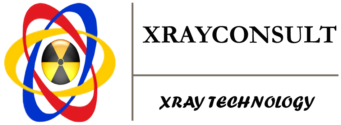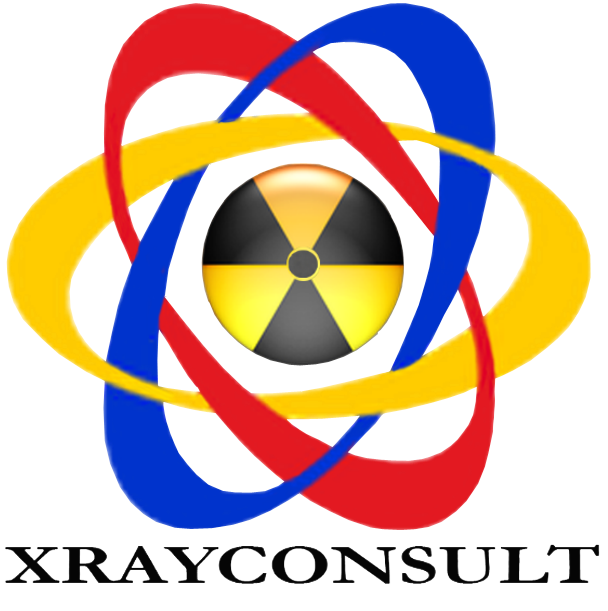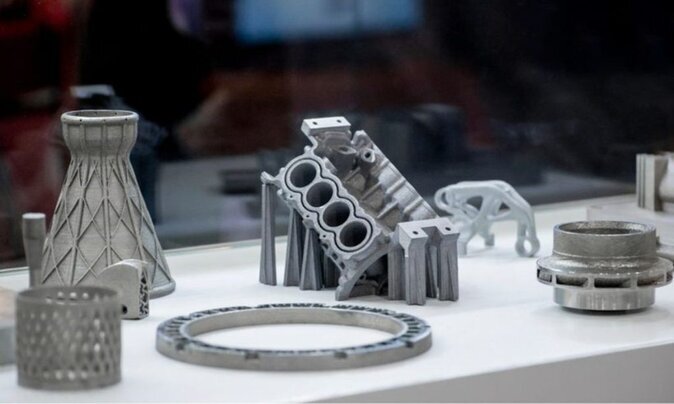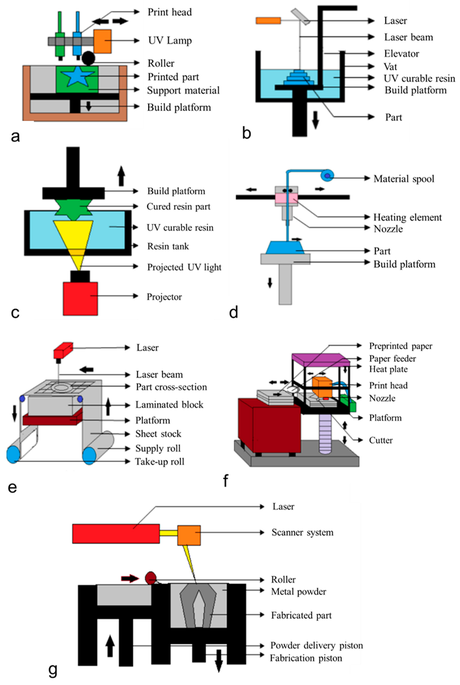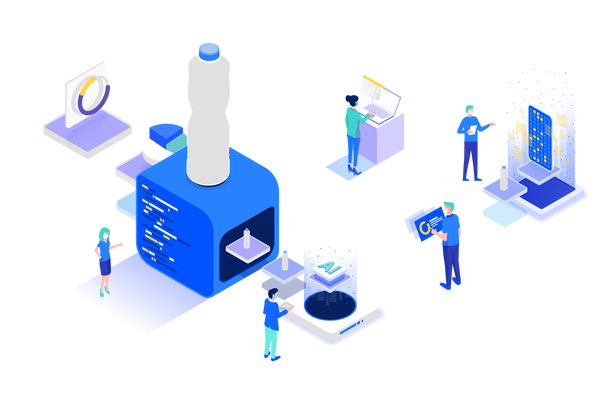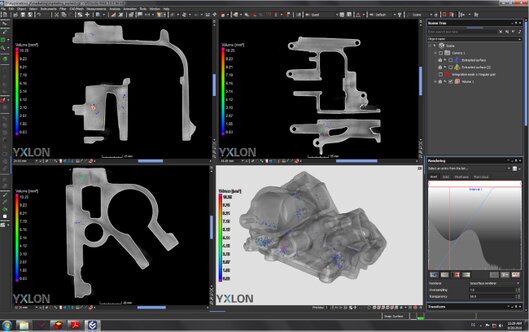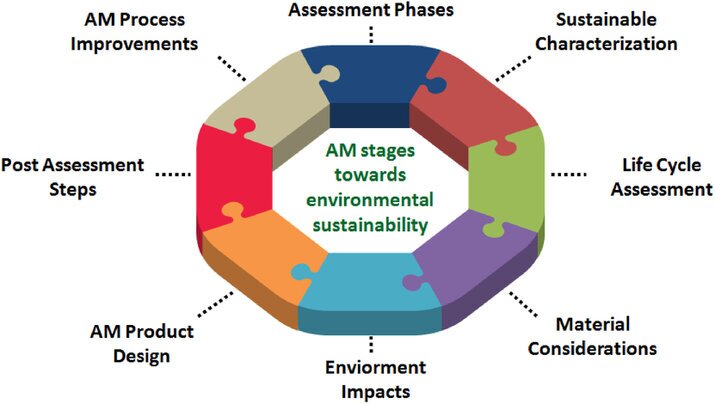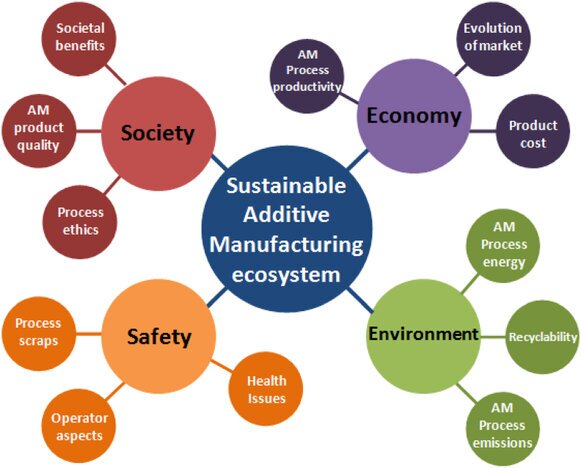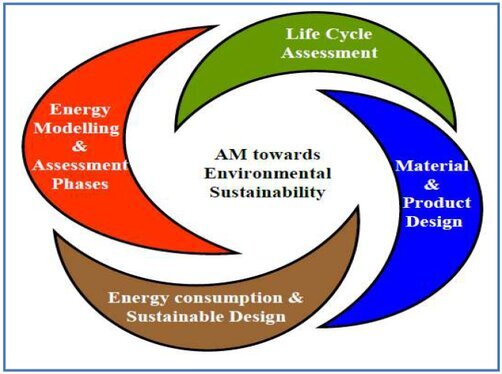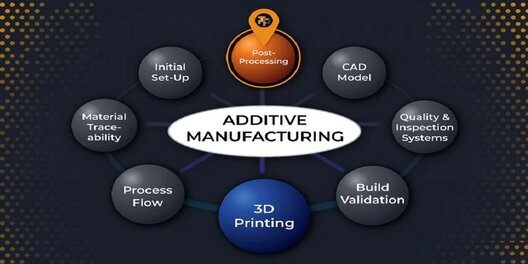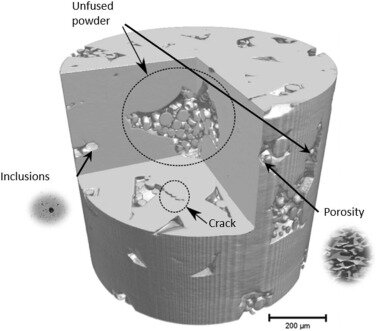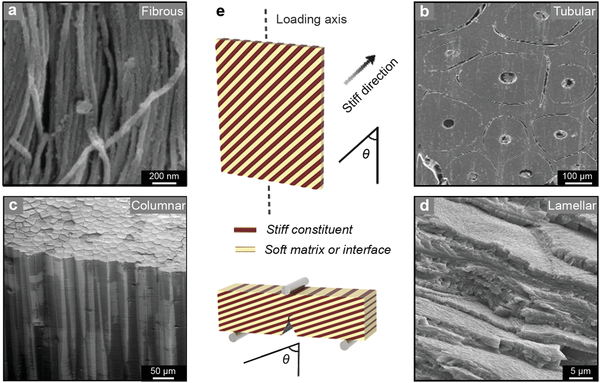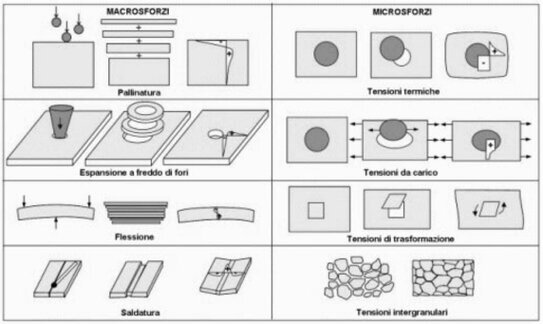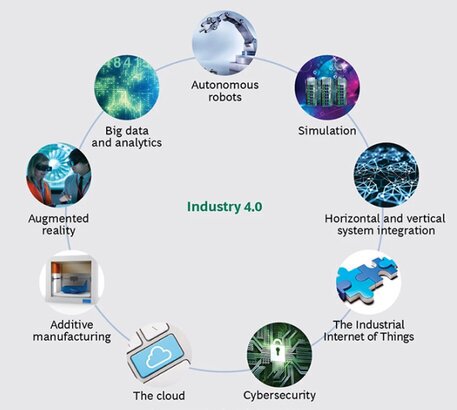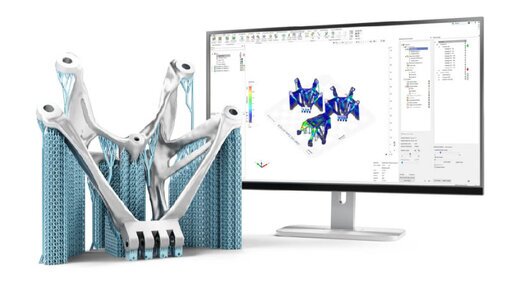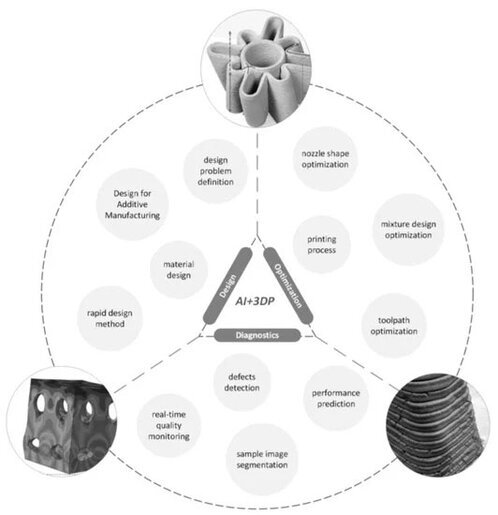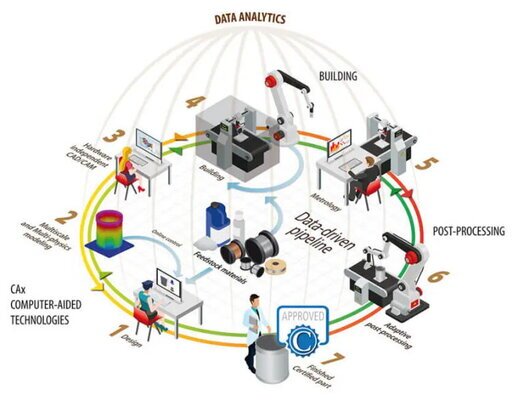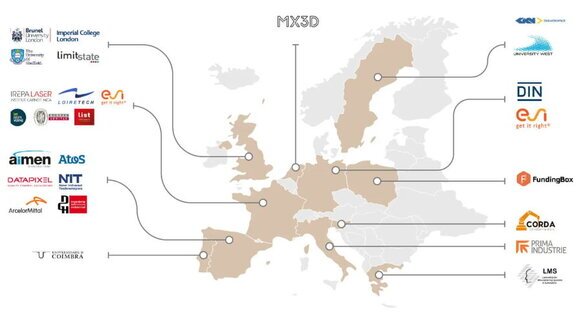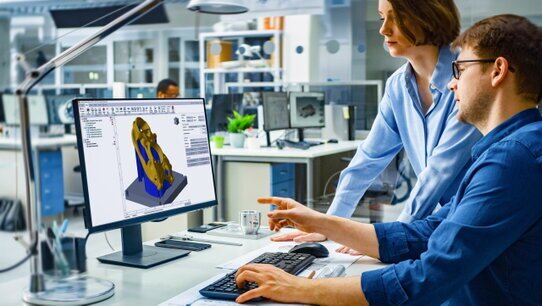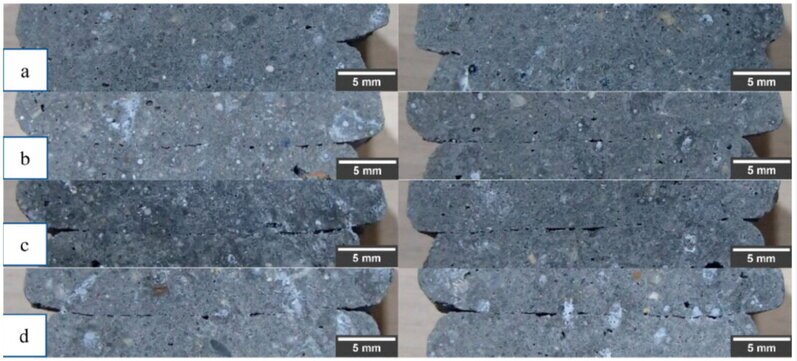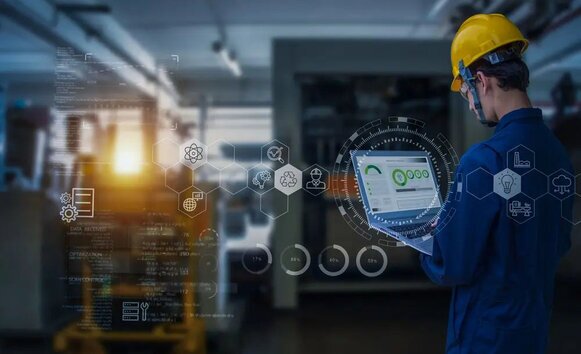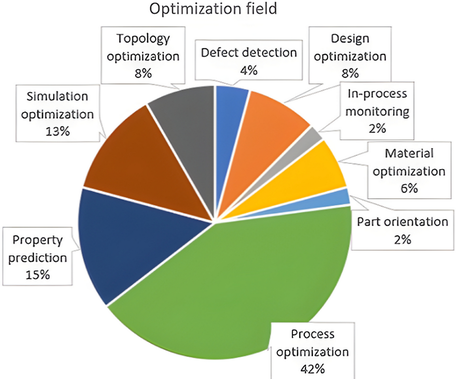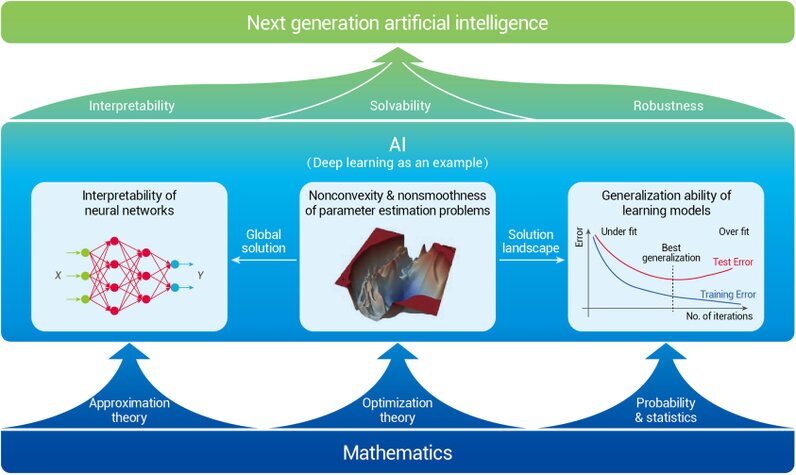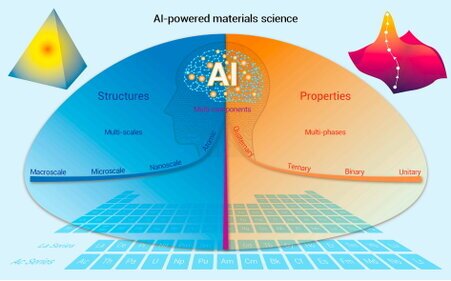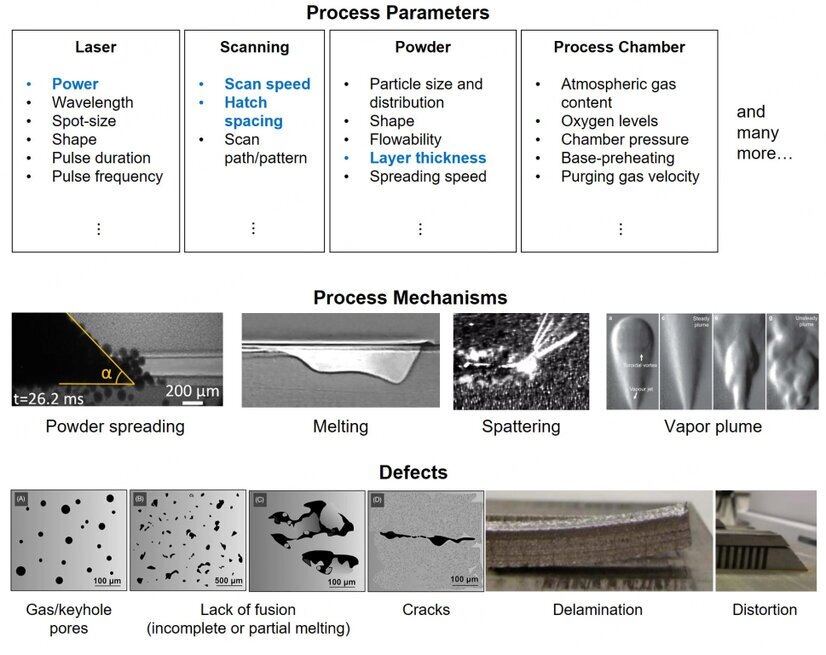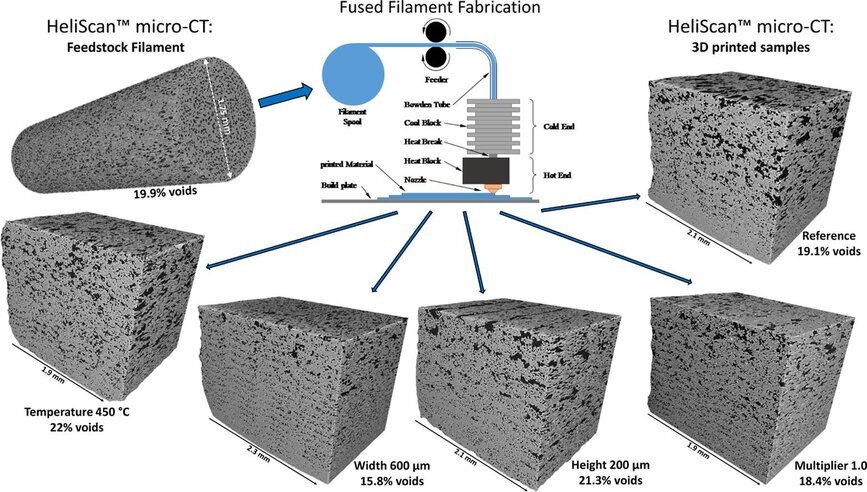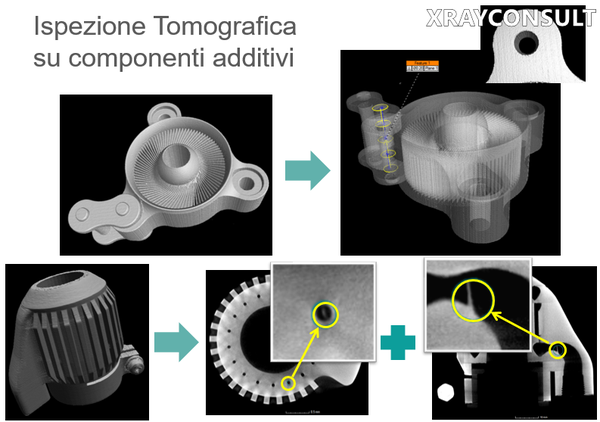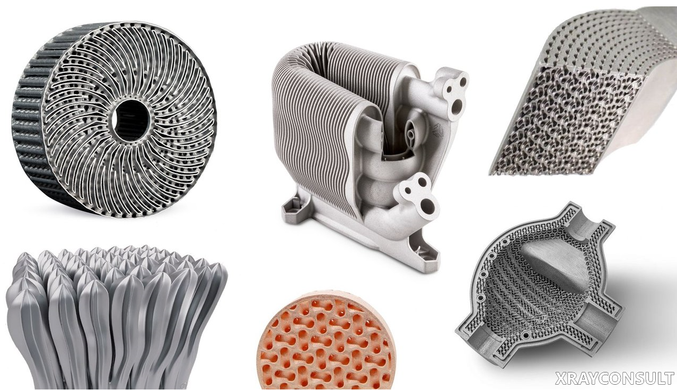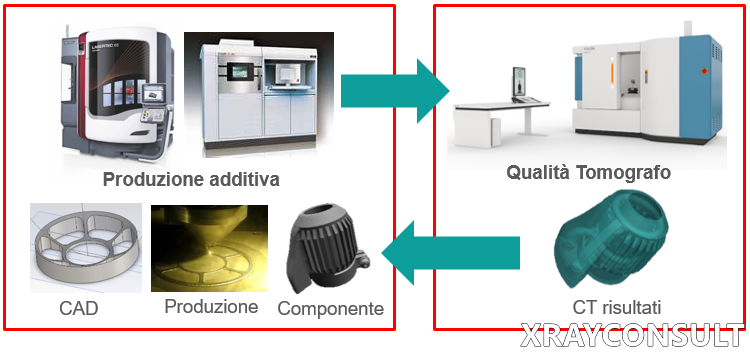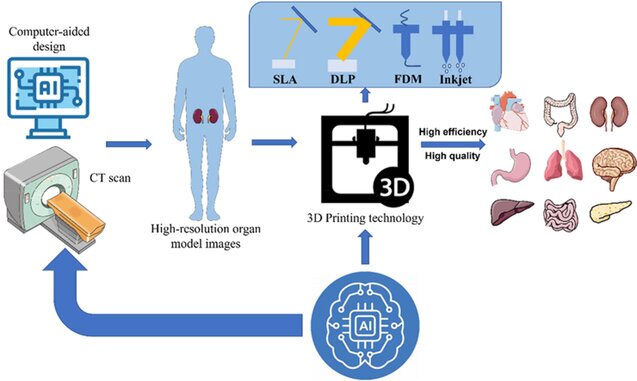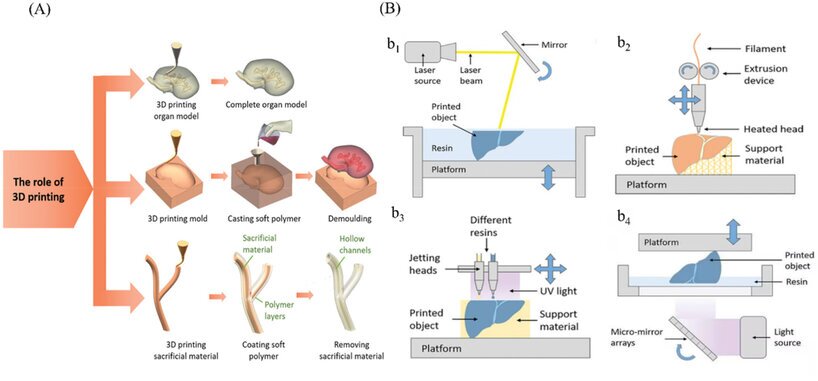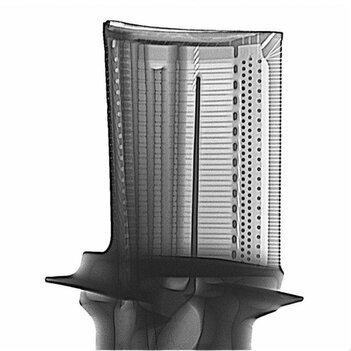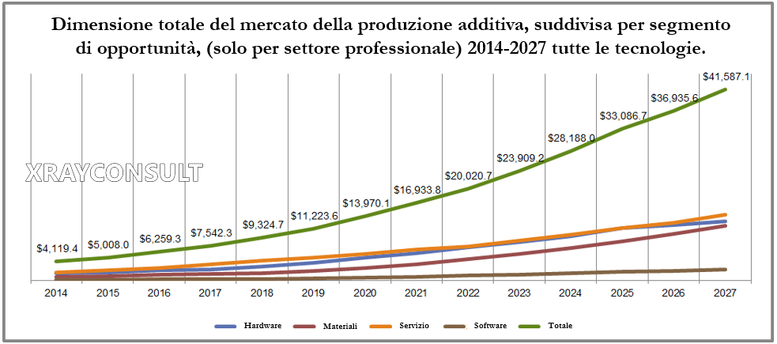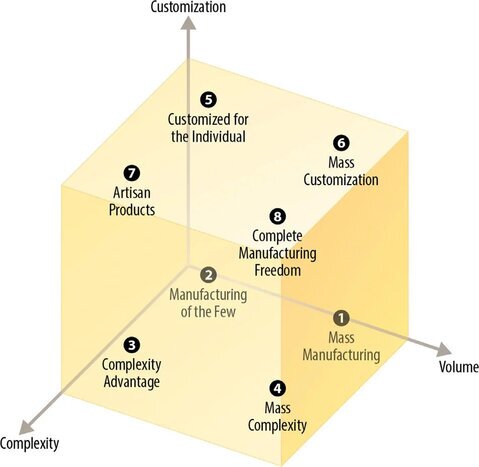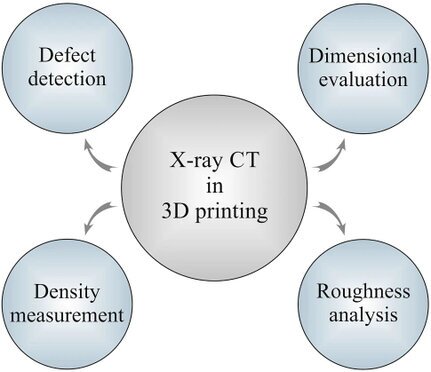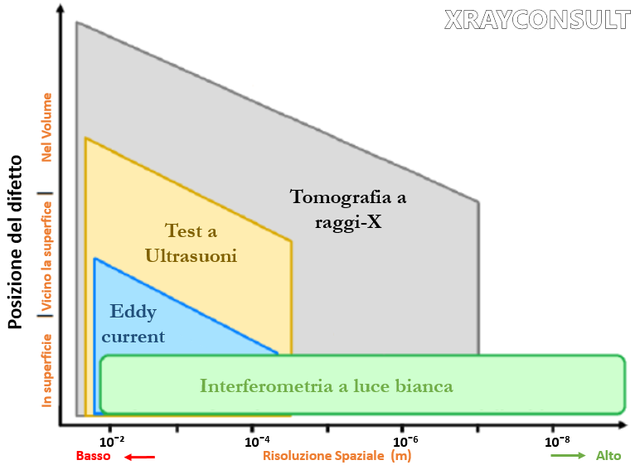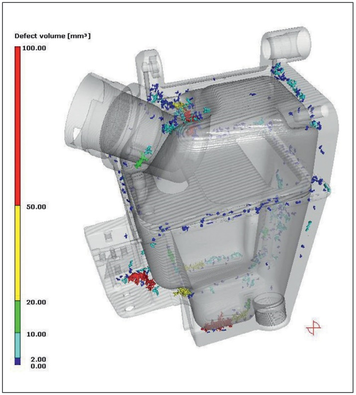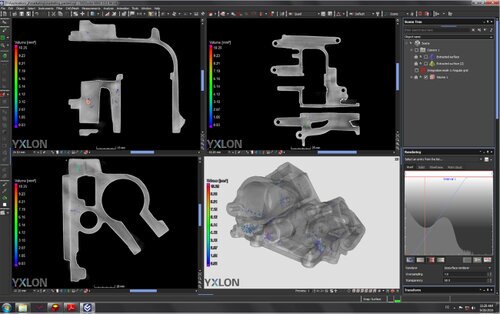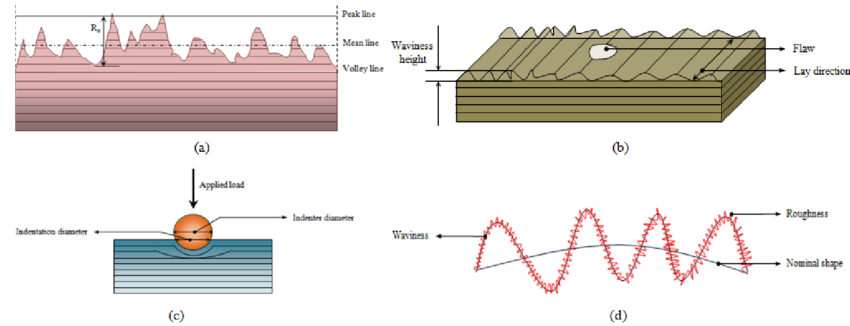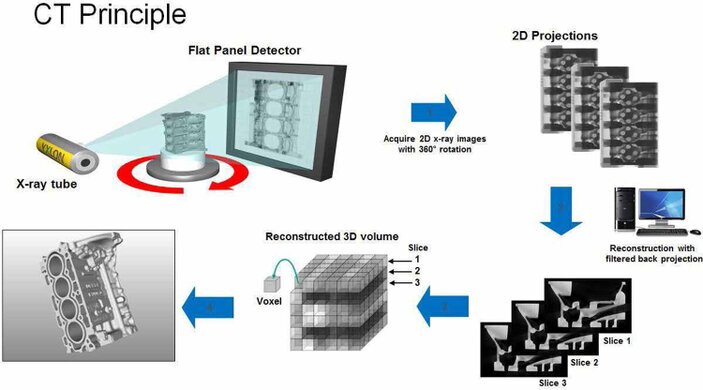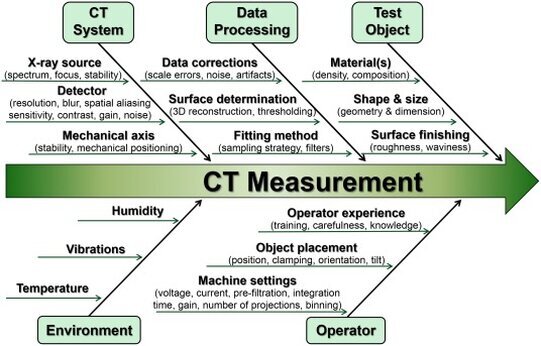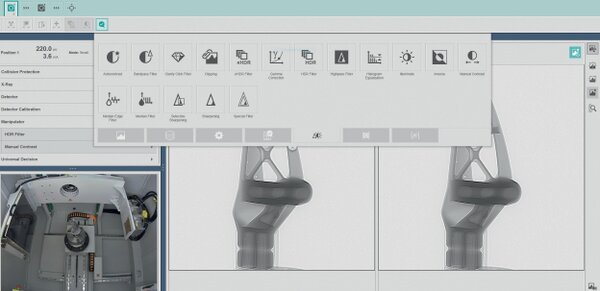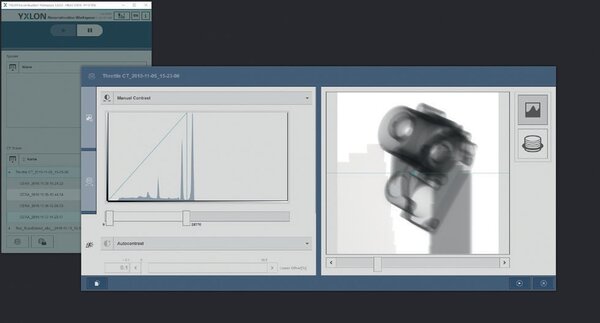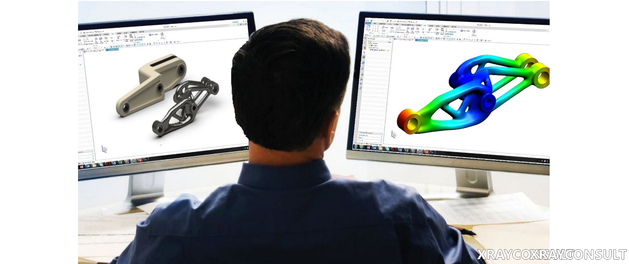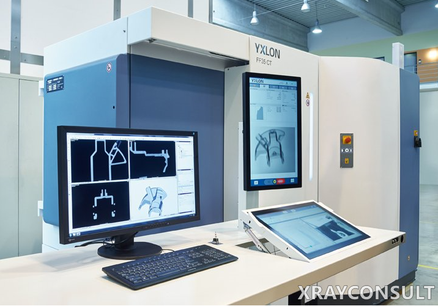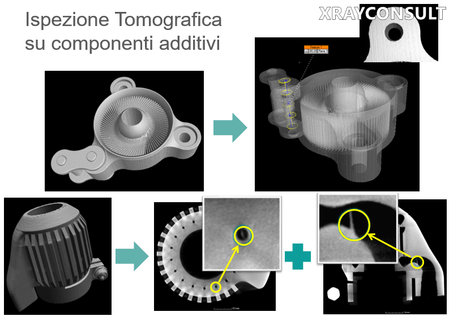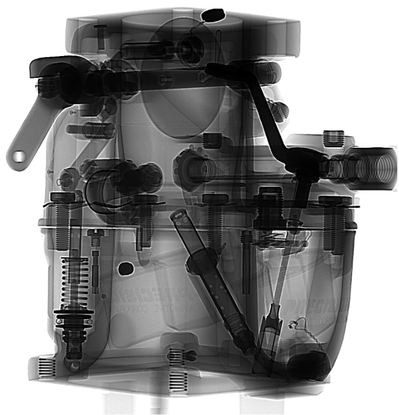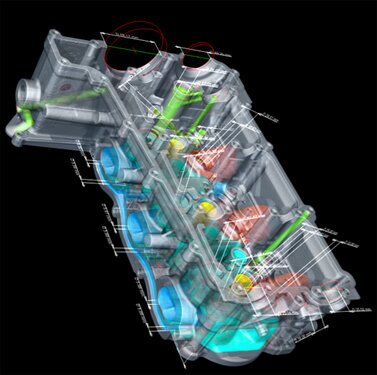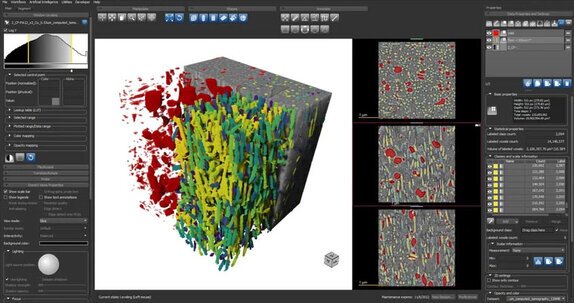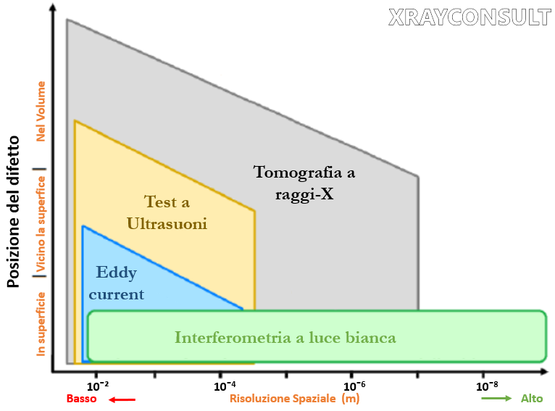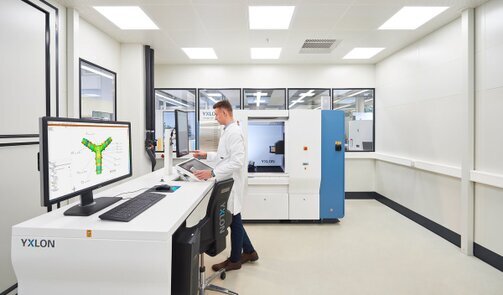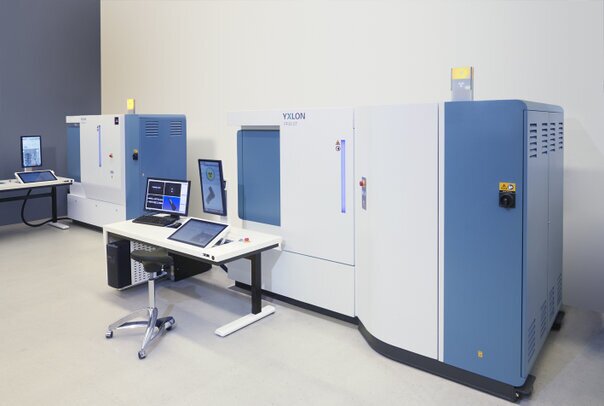PRINTING THE FUTURE: The Innovation behind AI and Tomography in 3D Production
Pubblicato da Brigida Michele in Xrayconsult · Sabato 25 Mag 2024 · 53:45
Tags: PRINTING, THE, FUTURE:, The, Innovation, behind, AI, and, Tomography, in, 3D, Production
Tags: PRINTING, THE, FUTURE:, The, Innovation, behind, AI, and, Tomography, in, 3D, Production
PRINTING THE FUTURE:
The Innovation behind AI and Tomography in 3D Production
1. Introduction to Additive Manufacturing and Artificial Intelligence
2. Material Efficiency in Additive Manufacturing
3. Intrinsic Limitations of AM Processes Leading to Defects
4. Introduction to the Integration of Artificial Intelligence in Additive Manufacturing
5. Integration of Artificial Intelligence in Additive Manufacturing: Optimizing Design and Product Quality
6. The Role of Artificial Intelligence in AM Optimization
7. The Role of Industrial Tomography in Additive Manufacturing
8. Additive Manufacturing, Artificial Intelligence, and Control via Industrial Tomography
9. Deep Dive into X-Ray Computed Tomography in Additive Manufacturing
10. The Social Benefits of Additive Manufacturing
11. The Impact of Additive Manufacturing on Artificial Intelligence and Control via Industrial Tomography
12. Fundamentals of Industrial Tomography and Its Role in Additive Manufacturing
13. Specific Applications of Industrial Tomography in Additive Manufacturing
14. Challenges and Limitations of Industrial Tomography
15. Optimizing Additive Manufacturing through Industrial Tomography and Artificial Intelligence
16. Limitations and Optimization of X-Ray CT
17. The Role of Artificial Intelligence in Solving Tomography Problems
18. Integrated Methods: Combining Tomography with Other Inspection and Measurement Techniques
19. Comet-Yxlon: Global Excellence in Metrological Tomography1. Introduction to Additive Manufacturing and Artificial IntelligenceAdditive Manufacturing (AM), also known as 3D printing, is revolutionizing the world of traditional manufacturing by enabling the creation of highly complex geometries and customized parts directly from digital designs.This innovative technology builds three-dimensional objects layer by layer using various materials such as plastic, metals, ceramics, and composites, eliminating the need for traditional tools.The integration of Artificial Intelligence (AI) into additive manufacturing processes is further enhancing this revolution.AI algorithms, with their ability to analyze vast datasets and identify patterns, are employed to predict and control the quality of 3D printed parts.By leveraging AI, manufacturers can reduce defects, optimize process parameters, and improve the overall efficiency of 3D printing.This article will explore the synergy between AI and AM, with a particular focus on the use of industrial computed tomography (CT) for quality control.Industrial CT is a non-destructive imaging technique that allows for detailed inspection, both internally and externally, of 3D printed parts.It is ideal for identifying defects such as porosity, cracks, and dimensional inaccuracies."Components Created with 3D Printing"Additive Manufacturing (AM), also known as 3D printing, is transforming traditional manufacturing by enabling the creation of highly complex geometries and customized parts directly from digital designs.This innovative technology constructs three-dimensional objects layer by layer from materials such as plastic, metals, ceramics, and composites, eliminating the need for traditional tools.Schematic diagram of the most common additive manufacturing processes: (a) PolyJet printing; (b) stereolithography (SLA);(c) direct light processing (DLP); (d) fused deposition modeling (FDM);(e) laminated object manufacturing (LOM); (f) selective deposition modeling (SDM);(g) selective laser sintering (SLS).Artificial intelligence (AI) plays an increasingly important role in optimizing AM processes.AI algorithms, with their ability to analyze vast data sets and identify patterns, can be used to predict and control the quality of 3D-printed parts.By integrating artificial intelligence into AM workflows, manufacturers can potentially reduce defects, optimize process parameters, and improve the overall efficiency of 3D printing.This article will explore the synergy between AI and AM, focusing particularly on the use of industrial computed tomography (CT) for quality control."Artificial Intelligence in Optimizing AM Processes"Industrial computed tomography (CT), a non-destructive imaging technique, allows for detailed internal and external inspection of 3D-printed parts, making it an ideal tool for identifying defects such as porosity, cracks, and dimensional inaccuracies.The following sections of this article will discuss how to leverage artificial intelligence to analyze CT scan data, enabling automated defect detection, process parameter optimization, and ultimately leading to more reliable and high-quality 3D-printed parts.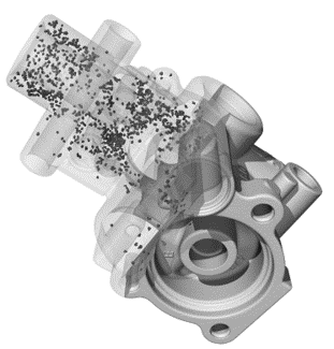
"Tomographic Volume" "Tomographic Analysis Screen"
2. Efficiency in Material Use in Additive ManufacturingAdditive manufacturing (AM), commonly known as 3D printing, represents a revolution compared to traditional subtractive manufacturing methods.This advanced technology builds parts layer by layer directly from 3D models, offering significant advantages in terms of material use efficiency.Unlike conventional manufacturing processes, which often involve removing material from a larger blank to achieve the desired shape, AM stands out for its ability to reduce waste and optimize resource use.Reduction of Material WasteOne of the main advantages of additive manufacturing is the significant reduction in material waste. In traditional manufacturing processes, especially when creating complex geometries, the excess material removed during machining is often treated as scrap.This can represent a considerable loss, particularly when using expensive materials like titanium alloys.With AM, material is deposited precisely where needed, thus minimizing waste generation.This efficiency can lead to substantial savings, reducing material costs and improving the sustainability of production."Process Flow of AM Phases Towards Enhancing Environmental Sustainability"Better Use of ResourcesBeyond reducing waste, additive manufacturing facilitates more efficient use of resources in several ways:
- Material Efficiency: Additive manufacturing builds parts layer by layer, making efficient use of raw materials and producing minimal waste. Conventional manufacturing relies on subtractive principles, which involve removing a large amount of material that often cannot be reused.
- Resource Efficiency: Unlike conventional manufacturing, which often requires jigs, fixtures, cutting tools, and coolants, additive manufacturing does not need these additional resources, allowing small manufacturers to produce a variety of parts.
- Part Flexibility: Additive manufacturing eliminates the constraints of tooling, allowing the production of parts with complex features in a single piece without sacrificing functionality. This also enables the creation of parts with variable mechanical properties.
- Production Flexibility: Additive manufacturing machines do not require expensive setups, making them suitable for small-batch production. Additionally, the quality of the parts depends on the process, not the operator's skills, allowing production to be synchronized with customer demand. This eliminates issues related to line balancing and production bottlenecks.
- Elimination of Specialized Equipment: Conventional manufacturing processes often require the use of specialized equipment such as molds, dies, jigs, and fixtures. These tools can be expensive to produce and often have limited use for specific projects. Additive manufacturing, on the other hand, requires minimal or no specialized equipment, thus reducing the necessary resources and associated production costs.
- Simplified Supply Chains: The ability of AM to produce parts on-demand and close to the point of need can significantly simplify supply chains. This localized production reduces the need for transportation, thereby decreasing energy consumption and the environmental impact associated with logistics and transportation of goods.
- Lightweight and Optimized Designs: Additive manufacturing allows the creation of complex designs, including intricate internal structures like lattices, which are difficult or impossible to achieve with traditional methods. These design possibilities enable the production of lighter components without compromising strength and functionality. The use of lightweight parts, particularly relevant in the aerospace and automotive sectors, helps reduce fuel consumption and emissions throughout the product's lifecycle.
"Sustainable Additive Manufacturing Ecosystem"
Economic and Environmental BenefitsThe benefits of additive manufacturing extend beyond material efficiency.By reducing reliance on specialized tools and enabling the creation of lightweight and optimized designs, AM helps make the production process more sustainable and economically advantageous.Waste reduction and resource optimization result in reduced environmental impact, making additive manufacturing an environmentally responsible choice.Additive manufacturing, with its ability to build parts layer by layer directly from digital models, offers a more efficient approach to material and resource use compared to traditional methods.By minimizing waste, reducing the need for specialized equipment, and enabling the creation of complex and lightweight designs, AM represents a step forward towards more sustainable and economically advantageous production.By integrating these advanced technologies, industries can not only improve their operational efficiency but also contribute to a greener and more sustainable future."Flusso del processo di AM verso la sostenibilità ambientale"3. Intrinsic Limitations of AM Processes Leading to Defects
- Layer-by-Layer Fabrication: The intrinsic nature of AM processes, which build parts layer by layer, introduces anisotropy into the final product.
This means that the mechanical properties of the part vary depending on the direction in which they are measured.This is because the bond between layers may not be as strong as the bond within a layer, leading to weakness in one direction.
"Fabbricazione strato per strato"
- Rapid Solidification: AM processes involve rapid heating and cooling cycles during the layer-by-layer fabrication process.
This can lead to high thermal gradients and rapid solidification rates, which can result in numerous defects.These rapid solidification rates can trap gases within the material, causing porosity.Rapid cooling can also lead to residual stresses within the part, which can cause deformations, distortions, or even cracking.
- Process Parameters: AM processes are sensitive to process parameters such as laser power, scanning speed, hatch spacing, and powder flow rate.
Even slight variations in these parameters can result in defects in the final part, including density variations, surface roughness, and mechanical properties.
"Process Parameters"
- Material Properties: The materials used in AM processes can also contribute to the creation of defects. Material properties, including powder size and shape, flowability, and thermal properties, can influence the quality of the final product.
The interaction of these limitations can lead to a variety of defects in AM parts, including:
- Porosity: Porosity is the presence of voids or holes within the material, which can weaken the part and reduce its fatigue life. Pores can be caused by trapped gas, incomplete melting of powder particles, or evaporation of binding elements.
- Cracking: Cracks can form due to the high thermal stresses generated during the rapid solidification process. Cracks can also occur due to the poor thermal conductivity of the material, resulting in uneven heating and cooling.
"Series of Defects in AM Parts"
- Delamination: Delamination occurs when the layers of a 3D printed part separate. This can be caused by weak bonding between the layers, residual stresses, or inadequate process parameters.
- Residual Stresses: Residual stresses are stresses that remain in a material after it has been processed. Residual stresses occur due to non-uniform heating and cooling during the AM process and can lead to distortion or deformation of the part.
- Surface Roughness: AM parts often have a rough surface finish, which can be detrimental to their mechanical properties and aesthetic appearance. Surface roughness occurs due to the staircase effect, which is the result of the layer-by-layer manufacturing process.
- Anisotropy: Anisotropy is the variation of material properties depending on the direction in which they are measured. It is caused by the layered structure of AM parts, which can lead to differences in strength, stiffness, and thermal conductivity in different directions.
(a-d) strutture anisotrope
Understanding these limitations and their impact on defect formation is crucial for researchers and manufacturers to optimize additive manufacturing processes, improve part quality, and expand the applications of this versatile technology.4. Introduction to Artificial Intelligence Integration in Additive ManufacturingIn the context of additive manufacturing (AM) or 3D printing, the provided documents offer a comprehensive overview of techniques, applications, and advancements.However, they primarily focus on the technical aspects of AM, with a focus on materials science, process parameters, and industry trends.While they do not specifically address the integration of artificial intelligence (AI) into AM, they emphasize the importance of process optimization and quality control.In particular, they highlight the need for real-time monitoring and adaptive control methods to address issues such as porosity, cracking, and thermal management in additive manufacturing processes.Additionally, they outline the growing role of automation in AM, including the use of automated guided vehicles, robots, and vision systems to enhance powder handling, part removal, and quality inspection.Based on general knowledge, artificial intelligence can play a significant role in these areas, improving efficiency and accuracy in AM.AI algorithms can be trained on large datasets to develop predictive models, optimize process parameters, and automate quality control.Furthermore, AI-based vision systems enable more sophisticated and automated inspection of AM parts."Industry 4.0 is the vision of the future of industrial production."Benefits of Additive ManufacturingAdditive manufacturing offers numerous advantages, including efficiency in material usage, as it builds parts layer by layer, reducing waste.Additionally, it requires fewer resources compared to conventional methods, allowing manufacturers to save costs and produce a wider variety of parts.The flexibility of parts is another significant advantage, as the technology eliminates tooling constraints, enabling the creation of complex parts without compromising functionality.Synergy between Additive Manufacturing, Artificial Intelligence, and Industrial Tomography.The integration of artificial intelligence and industrial tomography in additive manufacturing is an exciting prospect that promises to bring further benefits and innovations to the industry.AI can be employed to analyze CT scan data, enabling automated defect detection and real-time process parameter optimization.This can help ensure the production of more reliable and high-quality 3D printed parts.Furthermore, industrial tomography, with its ability to provide detailed inspection both internally and externally of 3D printed parts, proves to be a critical element in quality control.The combination of these technologies allows for accurate verification of produced components, enabling the identification and correction of any defects or anomalies during the production process."The Integration of Artificial Intelligence and Industrial Tomography"Future Perspectives and ImplicationsFully leveraging the potential of synergy between additive manufacturing, artificial intelligence, and industrial tomography will require close collaboration among industry experts, software developers, and imaging solution providers.However, the potential benefits are immense and could redefine the future of production.In addition to improving efficiency, accuracy, and part quality, this integration could open up new opportunities for design, manufacturing, and innovation in a wide range of sectors, from aerospace to the medical industry."Overview of Key Identified Uses for AI in Large-Scale 3D Printing (3DP)"The EU Commission's Integradde Project:Integradde is a project of the European Commission aimed at creating an interconnected digital ecosystem to promote interoperability and exchange among manufacturing companies.The goal is to develop a new production methodology based on additive manufacturing (AM), an innovative technique used in various industrial sectors such as aerospace, automotive, healthcare, and energy."The Integradde Project of the EU Commission"The Integradde Project:The Integradde project of the European Commission aims to create a digital and interconnected ecosystem to promote interoperability and exchange among manufacturing companies, thus fostering the development of additive manufacturing (AM).This innovative technology, already utilized in sectors such as aerospace, automotive, healthcare, and energy, involves producing components by adding material layer by layer, as opposed to traditional methods that subtract material from a solid block.Integradde focuses on the Direct Energy Deposition (DED) methodology to produce certified metal parts.The project integrates CAD/CAM technologies, Quality-by-Design production strategies, data analysis, and machine learning to optimize manufacturing processes, ensuring reliability and quality.ISO standards define seven additive manufacturing methods, including photo-polymerization, material jetting, fused deposition modeling, and selective laser melting, each with specific technical specifications and applications.The project's goal is to develop a new production methodology that allows European companies to collaborate within a secure and digital ecosystem, thereby improving efficiency and production quality.Additive manufacturing is seen as a crucial strategy for the advancement of the European manufacturing industry, promoting innovation and integration among continent-based companies.Integradde focuses on the production of certified metallic components through the Direct Energy Deposition (DED) process. The project aims to create a "data-driven intelligent ecosystem" to ensure manufacturability, reliability, and quality of components from the design phase.Key innovations include the "protected digital thread," open-source CAD/CAM technologies, Quality-by-Design (QbD) production strategies, data analysis, and machine learning, as well as product standardization."Major AM manufacturers in Europe"Application Sectors:
- Aerospace Industry: Production of lightweight and durable components for extreme conditions.
- Automotive Industry: Creation of complex geometries and lightweight components.
- Healthcare Sector: Customization of medical devices and functional prototypes.
- Energy Industry: Development of tailor-made components for extreme conditions.
Integradde represents a step towards a more united Europe in the manufacturing sector, promoting technological innovation and collaboration among businesses.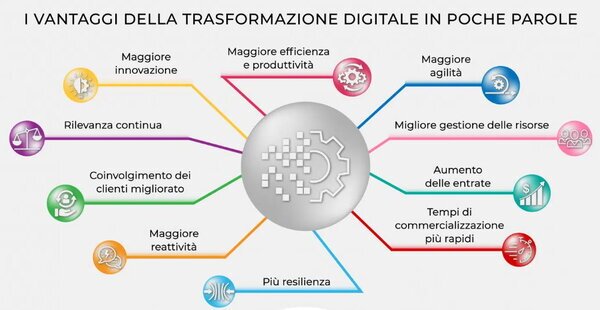 "Advantages of Digital Transformation"5. Integration of Artificial Intelligence in Additive Manufacturing: Optimization of Design and Product QualityThe manufacturing industry is undergoing an unprecedented revolution thanks to the increasingly widespread adoption of Additive Manufacturing (AM), commonly known as 3D printing.This technology has proven to be extremely promising due to its ability to create components with complex and customized geometries, allowing for a flexibility in design and production that was unthinkable with traditional methods.Simultaneously, artificial intelligence (AI) is emerging as a driving force in the manufacturing sector, offering a range of innovative solutions to optimize production processes and improve the quality of the final product.Phases of AI Integration in Additive Manufacturing:
"Advantages of Digital Transformation"5. Integration of Artificial Intelligence in Additive Manufacturing: Optimization of Design and Product QualityThe manufacturing industry is undergoing an unprecedented revolution thanks to the increasingly widespread adoption of Additive Manufacturing (AM), commonly known as 3D printing.This technology has proven to be extremely promising due to its ability to create components with complex and customized geometries, allowing for a flexibility in design and production that was unthinkable with traditional methods.Simultaneously, artificial intelligence (AI) is emerging as a driving force in the manufacturing sector, offering a range of innovative solutions to optimize production processes and improve the quality of the final product.Phases of AI Integration in Additive Manufacturing:
01. Design for Additive Manufacturing (DfAM): AI can be employed to analyze large amounts of data in order to identify the most suitable designs for AM.Through advanced algorithms, AI takes into account various factors such as build orientation, support structure, and material selection, enabling the creation of components optimized for additive manufacturing.This process not only reduces material waste but also leads to an improvement in product performance.
"Design for Additive Manufacturing (DfAM)"
02. Optimization of Process Parameters: Another area where AI can make a difference is in optimizing process parameters during AM production. By utilizing real-time sensor data, AI can analyze and adjust critical parameters such as laser power, scanning speed, and production chamber temperature.This data-driven approach minimizes defects and ensures higher quality of the final product, while also improving process repeatability.
"Qualitative Observation of Layer Bonding with Variable Printing Speeds: (a) 1-minute time interval,(b) 5-minute time interval, (c) 10-minute time interval, and (d) 20-minute time interval - gap"
03. Inspection and Quality Assurance: AI, combined with technologies such as industrial computed tomography (CT), can automate the inspection process of parts produced through AM.AI algorithms can analyze CT images to detect internal and external defects, such as porosity, inclusions, or other imperfections, which might not be visible with traditional inspection methods.This approach ensures greater reliability and compliance of the products.
"Defect detection by AI"
04. Predictive Maintenance: Finally, AI can also be employed for the predictive maintenance of equipment used in AM production.By analyzing data from sensors, AI can early detect signs of wear or potential failures, allowing for preventive interventions and reducing machine downtime.This helps maintain high levels of production efficiency and ensures greater operational continuity.
"Predictive Maintenance"6. The Role of Artificial Intelligence in Optimizing AMArtificial intelligence plays a crucial role in optimizing additive manufacturing (AM) processes, primarily by analyzing the vast amounts of data generated during fabrication to improve precision, efficiency, and quality control.Here's how artificial intelligence contributes to the optimization of additive manufacturing:
- Process Parameter Optimization: AI algorithms, particularly machine learning, analyze data from sensors that monitor parameters such as laser power, scanning speed, and powder flow rate. This analysis allows for real-time adjustments of these parameters, ensuring optimal build quality and minimizing defects.
- Defect Detection and Classification: AI-based vision systems and machine learning algorithms can detect and classify defects in AM parts with greater accuracy and speed than traditional methods. This enables early problem identification and reduces waste by allowing corrective actions during the build process.
- Real-Time Process Control: AI can be used to develop real-time process control systems for AM. This would enable adjustments to the AM process to be made on the fly to prevent defects from occurring in the first place.
- Predictive Maintenance: By analyzing sensor data, AI can predict potential machine failures before they occur. This allows for proactive maintenance, minimizing downtime and ensuring consistent AM system performance.
- Printability Analysis: AI algorithms can assess the printability of a design, determining whether it can be successfully produced using additive manufacturing. This saves time and resources by preventing attempts to realize unfeasible designs.
- Material Selection: AI can assist in selecting the best material for an AM application by considering factors such as strength, weight, and cost.
- Design Optimization: AI can help optimize designs for AM by suggesting features that enhance functionality, reduce material usage, and improve manufacturability.
"Optimization with Artificial Intelligence in Additive Manufacturing: A Systematic Review"Artificial intelligence, within the context of Industry 4.0, can potentially address various aspects of sustainability in additive manufacturing (AM), primarily by optimizing material usage and process efficiency:
- Lightweighting: Designing components with reduced weight while maintaining structural integrity (e.g., lattice design, topology optimization). This is particularly beneficial in industries such as aerospace and automotive, where reduced weight directly translates to fuel savings.
- Material Movement Reduction: AI can contribute to a distributed manufacturing model by analyzing data and optimizing production locations, thus reducing transportation needs and associated emissions.
- Process Efficiency: AI can enhance the sustainability of AM by improving the efficiency of the production process itself.
- Material Consumption: AI-based iterative design processes can significantly reduce material waste in AM. By analyzing large datasets and running simulations, AI algorithms can help achieve optimal material usage.
"The General Framework of AI"It is important to note that, although artificial intelligence holds great promise for improving the sustainability of AM, this field is still under development.Further research is needed to explore the full potential of AI in addressing sustainability challenges in AM and to develop robust and reliable AI-based systems for real-world applications.Artificial intelligence is not limited to individual aspects of AM; it can be integrated into a complete closed-loop system.This closed-loop system would function as follows:
- Data Acquisition: Sensors integrated into the AM system collect data on various parameters throughout the build process.
- Data Processing and Analysis: AI algorithms analyze the collected data in real-time to identify patterns, anomalies, and potential issues.
- Feedback and Control: Based on its analysis, the AI system provides feedback to the AM machine, adjusting process parameters or alerting operators to potential problems.
"It is anticipated that artificial intelligence will drive the development of materials science"7. The Role of Industrial Tomography in Additive ManufacturingAlthough there is no specific information on the use of AI in optimizing industrial tomography in the provided documents, it is clear that CT plays a fundamental role in inspecting and characterizing components produced through AM.CT enables the analysis of important structural features such as porosity, geometric deviations, and internal defects, thus contributing to the quality assurance of AM parts.In conclusion, the integration of AI into additive manufacturing represents a significant opportunity to improve efficiency, quality, and innovation in the manufacturing sector.While this technology is still in its early stages of development, its transformative potential is undeniable and deserves further exploration and development.With further technological advancements and practical implementations, AI will continue to play an increasingly important role in shaping the future of additive manufacturing.8. Additive Manufacturing, Artificial Intelligence, and Control via Industrial TomographyAs we delve into the fascinating world of additive manufacturing (AM) or 3D printing, we encounter a wide range of opportunities, challenges, and possibilities for innovation.Through the documents provided, we have gained a comprehensive view of the techniques, applications, and advancements in this constantly evolving sector.However, while these sources primarily focus on the technical aspects of AM, with an emphasis on materials science, process parameters, and emerging trends, there is a significant gap regarding the integration of artificial intelligence (AI) and control via industrial tomography in this context.Let's begin by analyzing the documents that emphasize the crucial importance of process optimization and quality control in AM.The need for real-time monitoring and adaptive control methods to address critical issues such as porosity, cracking, and thermal management during additive manufacturing processes is discussed.Furthermore, the growing role of automation in AM is clearly evident, with the increasingly widespread use of automated guided vehicles, robots, and vision systems to improve powder handling, part removal, and quality inspection.However, we cannot overlook the potential of artificial intelligence in this context.From my studies and general knowledge, I can confirm that AI can play a crucial role in optimizing AM processes.AI algorithms, especially in machine learning, have the ability to process vast datasets related to process parameters, material properties, and defect characteristics.Using this data, predictive models can be developed to anticipate potential defects, optimize process parameters in real-time, and automate quality control measures.Moreover, artificial intelligence can be integrated into vision systems used for inspection of AM parts.These AI-based systems enable more sophisticated and automated inspection, capable of identifying even the most imperceptible defects that may escape traditional inspection methods.However, additive manufacturing is not only about process optimization and quality control. Another fundamental component is industrial tomography, a non-destructive imaging technique that allows for detailed internal and external inspection of 3D-printed parts.This technology proves essential in the quality control process, enabling accurate verification of manufactured components and timely identification of any defects or anomalies.The synergy between additive manufacturing, artificial intelligence, and industrial tomography promises to bring further advantages and innovations to the manufacturing sector.However, to fully harness this potential, close collaboration between industry experts, software developers, and imaging solution providers is required.Only through effective cooperation and ongoing research and development can we fully realize the benefits of this integration, thus redefining the future of additive manufacturing and paving the way for new frontiers of innovation and industrial progress."Images of defects with different process parameters"An in-depth analysis of the microstructure of five CF/PEEK 3D printed samples and the commercial material used to produce them was conducted using micro-CT imaging.The images unequivocally reveal that both the raw material filament and the printed samples contain a significant amount of voids distributed heterogeneously.In the raw material filaments, voids are randomly distributed, while in the printed samples, they align in rows parallel to the mold plate.Short fibers are unevenly distributed and show a preferential alignment in all samples.9. Deep Dive into X-ray Computed Tomography in Additive ManufacturingIn the realm of additive manufacturing (AM) or 3D printing, X-ray computed tomography (CT) emerges as a key technology revolutionizing how we examine and evaluate produced parts.Unlike conventional inspection methods such as coordinate measuring machines (CMMs) or optical systems, X-ray CT provides an unprecedented level of detail, enabling a comprehensive and detailed examination of both the internal and external geometries of AM parts.AM, with its ability to create complex parts layer by layer directly from digital designs, presents unique challenges in terms of quality control and assessment of produced parts.X-ray CT stands out for its ability to detect subtle and complex internal defects, such as porosities, cracks, and inclusions, which may escape more traditional inspection methods.This is particularly crucial in high-criticality sectors such as aerospace and the medical field, where the safety and reliability of parts are of primary importance.The applications of X-ray CT in additive manufacturing are manifold and varied:
- Detection of Internal Defects: X-ray CT is particularly suitable for identifying internal defects in additively manufactured parts, such as voids, cracks, and inclusions, which are often inaccessible to traditional inspection techniques. This capability is essential for ensuring the structural integrity and reliability of these parts, especially in demanding applications such as aerospace or medical implants.
- Dimensional Measurement: Unlike tactile CMMs or optical measurement tools limited to external surfaces, X-ray CT provides comprehensive dimensional measurements of both internal and external geometries. It enables accurate evaluation of critical dimensions, including those of complex internal features, which is essential for assessing dimensional accuracy and compliance with the design specifications of AM parts.
"Dimensional Measurement of Components"
- Porosity Analysis: X-ray CT excels in porosity analysis of AM parts. By generating high-resolution 3D images, it allows for quantification of pore size, shape, distribution, and volume. This capability is vital for understanding the relationship between process parameters and porosity formation, enabling optimization of AM processes to minimize defects and improve material properties.
- Analysis of Complex Structures: X-ray CT is particularly well-suited for analyzing complex structures such as lattice structures commonly used in AM for lightweighting and biomedical implants. It can provide insights into strut thickness, pore size, and overall integrity of these intricate designs, supporting the development and optimization of such structures.
"Complex Structures Using AM"
- Powder Analysis: High-resolution X-ray CT can be used to analyze metal powders used in additive manufacturing. It allows for the identification of internal pores within powder particles, which can influence the behavior of the melt pool during the AM process, ultimately affecting the quality of the final part. Additionally, it can determine the real sphericity, volume, and surface area of powder particles, which are important parameters to ensure flowability and quality.
- Non-destructive Nature: X-ray CT is a non-destructive testing method, preserving the integrity of the inspected parts. This aspect is particularly important for high-value or complex AM parts, where destructive testing is not feasible or desirable.
In summary, X-ray CT represents a fundamental tool for quality control and process optimization in additive manufacturing.Its ability to provide detailed and accurate insights into AM parts contributes to ensuring the quality and reliability of produced components, opening new frontiers of innovation and progress in the field of advanced manufacturing."Quality Through Tomographic Inspection"10. The Social Advantages of Additive ManufacturingAdditive manufacturing, commonly known as 3D printing, represents a revolution in the manufacturing field, with a significant impact on various aspects of society.This innovative technology not only improves production efficiency but also brings numerous social benefits that are transforming different sectors, from healthcare to aerospace.Below, we examine the main social advantages resulting from the adoption of additive manufacturing.Efficiency in Material Usage and Resource ConsumptionOne of the main advantages of additive manufacturing is efficiency in material usage.Unlike traditional manufacturing methods that remove material to create shapes, AM builds objects layer by layer, using only the necessary materials.This approach minimizes material waste and reduces the need for additional resources such as cutting tools and coolants.This increased efficiency makes additive manufacturing more environmentally friendly and accessible to smaller manufacturers, allowing them to produce a variety of parts close to their customers.Improved Product Design and FunctionalityAdditive manufacturing eliminates the constraints of tools used in traditional production, allowing the creation of parts with complex geometries and features in a single piece.This capability opens up new possibilities for design innovation and expands the functionality of products without compromising ease of production.Designers can now create complex and lightweight structures that would be impossible or extremely difficult to achieve with traditional methods.Customization and PersonalizationAdditive manufacturing excels in producing customized products in small batches at relatively low costs.This advantage is particularly useful in fields such as medicine, where specific implants and devices are required for patients.The ability to create tailor-made products, adapted to individual needs, not only enhances the customer experience but can also significantly improve clinical outcomes and the quality of life for patients.Improvement of HealthcareAdditive manufacturing is making significant contributions to healthcare through the production of various medical devices."Additive Manufacturing in Organ Creation"Among these:
- Surgical Implants: By using patient data from CT and MRI scans, it's possible to create implants perfectly tailored to the individual, enhancing patient outcomes and comfort.
- Surgical Guides and Models: These tools assist surgeons in planning and executing complex procedures with greater precision.
- Dental Parts: Additive manufacturing enables the production of precise dental implants and prosthetics, enhancing patient care and satisfaction.
- Hearing Aids: The technology allows for the creation of customized and more effective hearing aids.
Here's a schematic diagram of the different types of direct and indirect printing:(A) Direct 3D printing of organ models, 3D printing of casting molds, and 3D printing of sacrificial material fabrication models.(B) b1 Stereolithography (SLA) b2 Fused Deposition Modeling (FDM) b3 Inkjet Printing b4 Digital Light Processing (DLP).Advancements in Other SectorsAdditive manufacturing is also revolutionizing other sectors:
- Aerospace: The technology enables the creation of lightweight and high-strength components for aircraft, reducing fuel consumption and emissions.
"Radioscopic View of an Aircraft Turbine Blade"
- Automotive Sector: Additive manufacturing is utilized to produce complex parts and prototypes, accelerating the design process and enabling the development of lighter and more efficient vehicles.
"Automated Design in AM"Economic Growth and Sustainability
The adoption of additive manufacturing can stimulate economies by creating jobs in technological development, manufacturing, and related services.Its sustainability benefits, such as waste reduction and energy consumption, contribute to a greener economy. Furthermore, the ability to produce parts locally reduces dependence on global supply chains, enhancing economic resilience."Chart of Growth in Various AM Sectors.Blue=Hardware Red=Materials Orange=Services Brown=Software Green=Total"Accessibility and DecentralizationAs additive manufacturing becomes more affordable and accessible, it has the potential to democratize production, enabling individuals and communities to create their own products.This shift could lead to more localized production, reducing transportation costs and emissions.Decentralizing production can also foster local innovation and entrepreneurship, allowing small businesses and individuals to compete on a global scale.Additive manufacturing offers a revolutionary approach to manufacturing, with significant benefits that go beyond production efficiency.By reducing waste, improving product design and functionality, enabling customization, and enhancing healthcare, AM is transforming how we produce and utilize goods.The social, economic, and environmental benefits of additive manufacturing make this technology a key element for the future of sustainable and innovative production."The three criteria for transitioning to additive manufacturing"11. Impact of Additive Manufacturing on Artificial Intelligence and Control Through Industrial TomographyAdditive manufacturing (AM), commonly known as 3D printing, represents a groundbreaking development in manufacturing.When combined with artificial intelligence (AI) and control through industrial tomography (CT), this technology is redefining production methods, improving efficiency, reducing waste, and optimizing supply chains.This blog explores how these technologies interact and the advantages they offer in terms of sustainability, efficiency, and innovation.Advantages in Terms of Sustainability of AdditiveManufacturing Resource Efficiency: Additive manufacturing is known for its efficient use of resources.Unlike conventional processes that require masks, specialized equipment, cutting tools, and coolants, AM builds objects layer by layer, using only the necessary material.This eliminates the need for auxiliary resources, minimizing waste and promoting sustainable production.Reduced Energy Consumption: Notably, in aerospace, where traditional methods can generate up to 90% waste material, additive manufacturing significantly reduces waste, thus decreasing the energy required for titanium material and component production.This results in lower energy costs and reduced environmental impact.Impact of Additive Manufacturing on Supply ChainsAdditive manufacturing has the potential to radically transform traditional supply chains through distributed production.Companies can now produce goods closer to customers or on-demand, reducing the need for warehousing and long-distance shipping.Shorter Supply Chains: The ability to produce components on-site drastically reduces shipping costs, delivery times, and overall carbon footprint.Localized production means companies can quickly respond to customer needs without maintaining large inventory stocks.Simplified Supply Chain Networks: AM facilitates the transition from a "made-to-stock" to a "made-to-order" model.This approach reduces dependence on warehouses, streamlining logistics, and reducing transportation and distribution complexities.Companies can manufacture directly at or near the customer's location, enhancing overall efficiency.Improved Flexibility and Responsiveness: Additive manufacturing offers unprecedented flexibility.Companies can quickly adjust production to meet changing market demands and customize products without significant tooling changes.The ability to rapidly prototype and iterate designs accelerates the product development process, enabling faster and more innovative launches.Challenges in Adopting Additive ManufacturingScalability and Costs: While AM is ideal for small batches and customized projects, it may not be as cost-effective for large-scale production cycles.The implementation and maintenance costs of AM technologies can be high, posing a challenge to their widespread adoption.Standardization and Quality Control: As a relatively new technology, additive manufacturing still faces issues of standardization and quality control.The lack of consistent quality standards and adequate certifications can hinder the widespread adoption of AM, especially in industries with stringent regulations.Additive manufacturing, combined with artificial intelligence and control through industrial tomography, is poised to revolutionize traditional supply chain models.As the technology continues to mature and overcome its inherent challenges, it will become increasingly integral to the future of production and supply chain management.The sustainability, efficiency, and innovation benefits make AM a strategic choice for companies aiming to remain competitive and environmentally responsible.12. Foundations of Industrial Tomography and Its Role in Additive ManufacturingIndustrial tomography, particularly X-ray computed tomography (CT), plays a crucial role in non-destructive testing within additive manufacturing.This technique, similar to medical CT, acquires cross-sectional images of an object without damaging it.A beam of X-rays is projected through the object and measured by a detector, allowing the creation of a 3D model.In additive manufacturing, industrial CT is essential for inspection and quality control, detecting internal defects, and ensuring the structural integrity of parts."Applications of CT in 3D Printing Technology""Advantages of Industrial Tomography in Additive Manufacturing
- Non-destructive nature: X-ray computed tomography (CT) is a non-destructive technique, meaning it can inspect the interior of parts produced through additive manufacturing without causing any damage. This contrasts with traditional inspection methods such as coordinate measuring machines (CMMs) and optical systems, which are limited to external measurements or require part destruction for internal inspection.
- Data richness: X-ray CT provides a three-dimensional volumetric dataset, offering a comprehensive view of the internal and external geometry of the part. This data richness enables various analyses, including porosity quantification, wall thickness measurements, and defect characterization based on size, shape, and position. In contrast, tactile CMMs provide point-wise measurements limited to accessible surfaces, offering a less complete picture of part conditions.
- Non-contact measurement: Being a non-contact technique, X-ray CT eliminates the risk of surface damage that can occur with tactile CMMs due to probe contact and movement. This is particularly important for delicate or complex AM parts that could be easily damaged by physical probing.
"Non-Contact Measurement with Tomography"
- Internal Defect Detection: CT excels in detecting internal defects such as cracks, voids, and porosities, which are common in additive manufacturing. It provides detailed 3D visualization and precise measurement of these defects, enabling manufacturers to assess the structural integrity of a part and identify potential failure points. This capability is crucial in sectors such as aerospace and medical, where part integrity is paramount.
- Comprehensive Defect Analysis: X-ray CT can identify a wider range of defects compared to tactile CMMs. For example, it can detect internal voids, inclusions (such as unfused powder), cracks, and porosities. These defects can have a significant impact on the structural integrity of AM parts, making their detection crucial. Tactile CMMs, being surface-limited, would not have noticed these internal defects.
- Dimensional Accuracy: CT offers high precision in dimensional measurements. It can create a complete 3D model of the part, allowing for precise comparison with the nominal design of the CAD model. This comparison helps identify dimensional deviations and ensures that the part meets required tolerances.
"Analysis of Complex Geometries"
- Analysis of Complex Geometries: The ability to inspect internal features is particularly valuable for parts produced additively, which often have complex internal geometries inaccessible by other inspection techniques. CT can analyze the intricacies of lattice structures, internal channels, and other complex features to ensure they are manufactured as intended.
- Material Inspection: In addition to dimensional accuracy, CT can also be used to identify inclusions or material defects within the part. This is particularly relevant for additive manufacturing processes using metal powders, where incomplete fusion or contamination can lead to imperfections in the final product.
- Data-Driven Insights for Process Optimization: The detailed 3D data generated by CT scans are not only useful for inspecting individual parts but can also be leveraged to optimize the additive manufacturing process itself. By analyzing the prevalence and characteristics of defects, manufacturers can adjust process parameters to minimize their occurrence, ultimately improving the reliability and quality of the additive manufacturing process.
While the sources provide a solid foundation for understanding the benefits of tomography in additive manufacturing, they do not extensively discuss its use alongside artificial intelligence.To thoroughly explore the integration of artificial intelligence in this context, you may want to independently verify information from additional sources."Features of Different NDT Systems"13. Specific Applications of Industrial Tomography in Additive ManufacturingPorosity Analysis: Identifying and quantifying the porosity of parts is essential for understanding the influence of process parameters on defects and mechanical properties.The presence of porosity can compromise the structural strength of parts, so its accurate evaluation is crucial to ensure component quality."Tomographic Image with Dimensional Indication of Porosity"Defect Analysis: X-ray CT is used to analyze internal defects in AM parts, such as porosity.The technique is valuable because it is non-destructive and can identify defects that would not be visible with traditional inspection methods.For example, X-ray CT can be used to identify small pores and voids within a part, as well as their size, shape, and distribution.This information can be used to assess the quality of a part and determine if it meets the required specifications.Dimensional Metrology: X-ray CT is used to measure the dimensions of AM parts, including internal features that would be inaccessible to traditional measurement techniques such as CMM.The technique is particularly useful for measuring complex parts, such as those with internal cavities or lattice structures.For example, X-ray CT can be used to measure the wall thickness of a part, the diameter of internal channels, and the spacing of lattice struts.This information can be used to verify that a part has been manufactured to the correct specifications.Surface Roughness Evaluation: X-ray CT analyzes the topography of surfaces, essential for understanding the surface characteristics of AM parts.Surface roughness evaluation is important to ensure the proper functioning of parts in applications where surface-to-surface contact or specific surface finish is required.Industrial CT stands out as a valuable method for assessing the quality and integrity of additively manufactured parts, providing detailed information that is difficult to obtain with other means.With its ability to detect internal defects, measure accurately, and analyze material properties, industrial CT represents an essential resource for ensuring the quality and reliability of AM parts.Thanks to its versatility and precision, industrial tomography continues to play an increasingly important role in modern additive manufacturing.Surface Characteristics: (a) surface roughness parameters, (b) surface finish parameters,(c) surface hardness, and (d) components of surface topography.14. Challenges and Limitations of Industrial TomographyDiscussion of technical, economic, and operational limitations and challenges related to the use of industrial tomography in additive manufacturing (AM) contexts.Although the provided sources highlight the benefits of X-ray computed tomography (CT) in additive manufacturing (AM), they only briefly mention the challenges.One source states that costs and the lack of standards are the main drawbacks for broader adoption of CT in AM.
- Cost: The sources emphasize the importance of CT as a tool for dimensional quality control, geometric tolerance verification, and defect analysis in AM. However, the acquisition and maintenance costs of industrial CT systems are high compared to more traditional inspection methods, which can be a limiting factor, especially for smaller businesses.
- Lack of standards: The successful adoption of any quality control technology depends largely on the presence of standardized procedures and guidelines. The lack of established standards for the use of CT in AM creates uncertainty about best practices for data acquisition, analysis, and result interpretation. This lack of standardization makes it difficult to compare results from different studies, hindering the development of robust quality control protocols.
In addition to these explicitly mentioned challenges, we can infer other potential limitations from the original materials provided:
- Data processing and analysis: CT scans generate large volumes of data. Extracting meaningful information from this data requires specialized software and expertise in CT image processing and analysis. This complexity can be a challenge for companies that do not have dedicated personnel trained in CT data analysis.
- Material limitations: Although not explicitly discussed as limitations, the sources mainly focus on metal AM. It is important to note that the effectiveness of CT may vary depending on the material being scanned. Dense materials like metals provide good contrast in CT images, while lighter materials like polymers may require different imaging parameters or specialized CT systems for effective inspection.
- Integration into production workflow: The sources present CT as a valuable tool for analyzing AM parts after their production. However, integrating CT into a real-time or near-real-time production workflow for continuous process monitoring poses significant challenges. This integration would require advances in high-speed scanning and automated defect detection algorithms.
The sources do not provide specific details on the use of artificial intelligence (AI) in conjunction with CT for AM. To better understand how artificial intelligence could address some of these limitations, you may want to consult additional sources.15. Optimization of Additive Manufacturing through Industrial Tomography and Artificial IntelligenceAdditive manufacturing (AM) has revolutionized the manufacturing industry, enabling the creation of complex components with unprecedented precision.However, ensuring the quality and reliability of these parts remains a crucial challenge. In this context, industrial tomography (CT) and artificial intelligence (AI) emerge as fundamental tools for inspection and process control.Foundations of Industrial Tomography (CT)TI, particularly X-ray computed tomography (CT), is a non-destructive inspection technique that acquires cross-sectional images of an object without damaging it.By projecting an X-ray beam onto the object and measuring the intensity of the X-rays passing through it, detailed three-dimensional data can be obtained.In the context of additive manufacturing, CT plays a crucial role in identifying internal defects and confirming the dimensional accuracy of parts.Advantages of X-ray CTX-ray computed tomography (CT) is a valuable tool for the inspection and analysis of additively manufactured (AM) parts due to its non-destructive nature and its ability to visualize internal features.Overall, X-ray CT plays a crucial role in advancing the field of AM by providing valuable insights into the microstructure, properties, and performance of AM parts.Its ability to non-destructively image and analyze internal features makes it an indispensable tool for quality control, process optimization, and research and development in AM.The achievable resolution of X-ray computed tomography (CT) when used for dimensional measurements of additively manufactured parts is on the order of 10-5 µm.The factors that can influence the performance of X-ray CT systems and potentially affect resolution include:
- Resolution and magnification.
- Image contrast/signal-to-noise ratio.
- Sampling strategy.
- X-ray energy spectrum.
- Object geometry and size.
- Sub-voxel edge interpolation.
These detailed pieces of information can be useful for understanding the factors influencing the resolution of X-ray CT.The "rule of thumb" for typical microCT with geometric magnification is that the resolution is 2000 times smaller than the widest part of the sample, or 1000 times smaller if sample angles and artifact reduction are taken into account, limiting the achievable resolution with larger samples.For example, the best voxel size for a 20 mm part would be 10 µm.This means that the achievable resolution depends on the size of the object being scanned, with smaller objects allowing for higher resolution, highlighting an important consideration for selecting X-ray CT as an inspection tool.16. Limitations and Optimization of X-ray CTHowever, CT has some limitations, including part size, minimum detectable pore size, and balancing scan time with image quality.Overcoming these limitations requires a combination of advanced scanning techniques and optimization of process parameters.
- Part Size: Part size can influence the quality of CT imaging. Large parts require high scanning voltages and X-ray filtering, which can compromise resolution and the ability to detect smaller defects.
- Minimum Detectable Pore Size: The minimum detectable pore size depends on the scanning voxel size. This can limit the ability to detect thin defects or microscopic porosity, especially in small parts.
- Balancing Scan Time: There is a trade-off between scan time and image quality. Faster scans may compromise image quality, while high-quality scans require more time and additional costs.
"Variables in Metrological Tomographic Inspection"Role of Artificial IntelligenceAI plays an increasingly important role in the analysis and interpretation of CT data.Advanced algorithms can automatically identify defects and anomalies, enabling faster and more efficient evaluation of parts.Additionally, AI can be used to optimize process parameters, predict defect formation, and overall improve the quality of additively manufactured parts.Applications and ChallengesAI and X-ray CT find applications across a wide range of industries, from aerospace to medical.However, there are challenges to address, such as the need to standardize processes and ensure data security.The integration of industrial tomography and artificial intelligence represents a significant step towards high-quality and reliable additive manufacturing.By overcoming the limitations of CT and harnessing the potential of AI, companies can improve the quality of their parts, reduce costs, and accelerate the product development process.Despite all its advantages, X-ray CT also has limitations, such as costs and the potential for artifacts in metal parts.However, ongoing technological advancements are addressing these limitations, leading to the development of faster, more cost-effective CT systems with higher resolution that can further enhance quality control and process optimization in AM.17. Role of Artificial Intelligence in Addressing Tomography ChallengesThis section examines how artificial intelligence helps overcome some of the challenges of tomography by improving data analysis and result interpretation.While the provided research articles offer substantial information on the use of industrial computed tomography for additive manufacturing inspection and also touch upon the role of artificial intelligence in enhancing additive manufacturing processes, they do not specifically address how artificial intelligence can be used to overcome challenges in tomography itself."The diverse phases in tomographic verification"
- Predictive maintenance in AM: Artificial intelligence contributes to predictive maintenance of AM systems, potentially leading to more reliable machine operation and higher quality parts, thereby reducing the burden on tomography for defect identification.
- Data analysis and interpretation: Artificial intelligence is integral to processing and interpreting large datasets, which is valuable in AM for analyzing sensor data and optimizing processes, but its application to tomographic data analysis.
The advent of additive manufacturing (AM) combined with the power of artificial intelligence (AI) and the precision of industrial tomography (CT) is revolutionizing the non-destructive testing sector."Manutenzione predittiva nell’AM"Here are some thoughts on the impact of these technologies and potential directions for future research and development:
- Industrial tomography for quality control: CT has emerged as a well-established method for testing and analyzing additively manufactured parts, proving particularly useful for dimensional measurement and porosity analysis. Its non-destructive nature allows for a comprehensive assessment of the structural integrity of components, identifying internal defects such as cracks or voids that may not be detectable with other methods.
"The FF35 Tomography System by Comet-Yxlon"
- AI for AM Process Optimization: While specific examples of AI application to control via industrial tomography were not provided in the texts, AI can play a significant role in optimizing the entire AM process. For instance, AI algorithms can analyze CT data to automatically detect defects, classify their severity, and even suggest changes to process parameters to prevent their formation.
- AI-CT Integration: The combination of AI and CT offers tremendous untapped potential. Future developments could focus on integrating these technologies to create automated and intelligent quality control systems. These systems could, for example, automatically adjust printing parameters in real-time based on CT analysis, thus ensuring the production of parts with exceptionally high-quality standards.
"Defect Inspection in Additive Manufacturing"Future Research and Development Directions:
- Advanced AI Algorithms: More sophisticated AI algorithms are needed for automated analysis of large CT datasets, enabling rapid and reliable identification and classification of increasingly smaller and complex defects.
- Real-time CT Systems: Developing faster CT systems capable of providing real-time feedback during the printing process could enable unprecedented process control and immediate correction of any defects.
- Standards and Certifications: The widespread adoption of these technologies requires the establishment of clear and shared standards and measurement protocols to ensure quality, reliability, and reproducibility of results.
"X-ray Radiography Image"The intersection of AM, AI, and industrial tomography represents an exciting area of research with tremendous potential for the future.Further developments in this field promise to lead to more efficient, sustainable, and automated production processes, paving the way for a new era of advanced manufacturing.18. Integrated Methods: Combining Tomography with Other Inspection and Measurement TechniquesIn the final chapter, we will examine how tomography can be integrated with other inspection and measurement techniques to achieve a more comprehensive and detailed view of the objects under examination.We will see how the integration of these methodologies can lead to more accurate and reliable results.Integrated Methods: Combining Tomography with Other Inspection and Measurement TechniquesIn the pursuit of a complete and detailed understanding of the objects under examination, the integration of tomography with other inspection and measurement techniques plays a crucial role.In this final chapter, we will explore how this synergy can lead to more accurate and reliable results, offering a deeper insight into the structure and characteristics of the objects.
"Tomographic Image with Metrological Measurement"Complementarity of Inspection TechniquesOne of the main reasons for integrating tomography with other inspection techniques is the complementarity of the information provided by each methodology.While tomography offers a three-dimensional view of the object and its internal structures, other techniques such as radiography, electron microscopy, or laser scanning can provide additional details on specific aspects such as chemical composition, surface, or material microstructure.Increased Precision and ReliabilityThe integration of different inspection and measurement techniques also allows for increased precision and reliability of analyses.Combined together, these methodologies can offset each other's limitations and provide a more comprehensive and accurate assessment of the objects under examination.For example, the joint use of tomography and optical microscopy can enable a more detailed characterization of material microstructures, enhancing the understanding of their mechanical and thermal properties.Optimization of Inspection ProcessesIntegrating tomography with other inspection and measurement techniques also contributes to the optimization of inspection processes.By harnessing the specific capabilities of each technique, it is possible to design customized inspection approaches that maximize efficiency and effectiveness of the analysis.This can lead to reduced inspection times, increased productivity, and better quality of the obtained data."Tomographic Analysis"Practical ApplicationsThe practical applications of integrating tomography with other inspection techniques are diverse and varied.These include inspecting complex mechanical components in the automotive industry, analyzing materials in aerospace, and characterizing artistic artifacts in the cultural sector.In each case, the combined use of various methodologies allows for a comprehensive and accurate assessment of objects, supporting critical decisions and promoting innovation and technological development.In conclusion, integrating tomography with other inspection and measurement techniques offers a comprehensive and multidisciplinary approach to object analysis.This synergy allows for a deeper and more accurate understanding of the structure and characteristics of objects, improving the precision, reliability, and efficiency of the analyses conducted.These twelve chapters constitute a thorough journey through industrial and metrological tomography, providing a comprehensive overview of their applications, techniques, and challenges.Whether you are a industry professional or a technology enthusiast, this manual will guide you through the depths of these continuously evolving disciplines."Table of Different Control Systems in AM"19. Comet-Yxlon: Global Excellence in Metrological TomographyWith a rich history of innovation and success in the field of metrological tomography, Comet-Yxlon stands as a pillar of the industry, offering reliable and cutting-edge solutions that meet the most demanding requirements of the sector.A Legacy of Excellence: Founded on the legacy of two giants in the inspection and metrology sector, Comet and Yxlon, the company boasts a history dating back decades of experience and expertise.The merger of these two powerhouses created a unique synergy, leading to the birth of Comet-Yxlon and solidifying its position as a global leader in metrological tomography.Global Presence: With a established presence worldwide, Comet-Yxlon serves a wide spectrum of industrial sectors in every corner of the globe.From the automotive and aerospace industries to medical and research applications, Comet-Yxlon's products are trusted by companies of all sizes for their inspection and measurement needs.Commitment to Innovation: Comet-Yxlon remains at the forefront of innovation in the industry, consistently investing in research and development to anticipate market trends and introduce cutting-edge technological solutions.This constant commitment to innovation ensures that Comet-Yxlon's customers have access to the latest technologies and best practices in the field of metrological tomography.Tailored Solutions: Comet-Yxlon understands that every application has unique requirements.Therefore, it offers customized and tailored solutions to meet the specific needs of customers.From standard inspection systems to fully customized solutions, Comet-Yxlon works closely with its customers to ensure that their needs are fully met.
"White Room for Metrological Tomography"Custom Solutions: Comet-Yxlon understands that every application has unique requirements.Therefore, it provides customized and tailor-made solutions to meet the specific needs of customers.From standard inspection systems to fully customized solutions, Comet-Yxlon works closely with its clients to ensure that their needs are fully met.Global Quality Standards: Comet-Yxlon is committed to providing products and services of the highest quality, ensuring compliance with the most rigorous industry standards.Each facility undergoes stringent testing and quality controls to ensure optimal performance and long-term reliability.In conclusion, Comet-Yxlon represents a benchmark in the metrological tomography industry, combining a rich history of success with unparalleled global expertise in the sector.Thanks to its global presence, commitment to continuous innovation, and impeccable quality standards, Comet-Yxlon continues to lead the industry towards new frontiers of excellence and performance.
"Tomography and Micro-Tomography Systems by Comet-Yxlon"Xrayconsult is always available to provide information on this technology.The information presented in this text is based on authoritative sources and can be verified through the following bibliography:
- Gibson, I., Rosen, D. W., & Stucker, B. (2015). "Additive Manufacturing Technologies: 3D Printing, Rapid Prototyping, and Direct Digital Manufacturing."
- Gebhardt, A. (2011). "Understanding Additive Manufacturing: Rapid Prototyping, Rapid Tooling, Rapid Manufacturing."
- Campbell, I., Bourell, D., & Gibson, I. (2012). "Additive Manufacturing: Rapid Prototyping Comes of Age."
- Lipson, H., & Kurman, M. (2013). "Fabricated: The New World of 3D Printing."
- Bandyopadhyay, A., & Bose, S. (2015). "Additive Manufacturing."
- Hopkinson, N., Hague, R., & Dickens, P. (2006). "Rapid Manufacturing: An Industrial Revolution for the Digital Age."
- Chua, C. K., & Leong, K. F. (2014). "3D Printing and Additive Manufacturing: Principles and Applications."
- Huang, Y., Leu, M. C., Mazumder, J., & Donmez, A. (2015). "Additive Manufacturing: Current State, Future Potential, Gaps and Needs, and Recommendations."
- Sun, W., Starly, B., Darling, A., & Shirwaiker, R. (2015). "Computer-Aided Tissue Engineering."
- Thompson, M. K., Moroni, G., Vaneker, T., Fadel, G., Campbell, R. I., Gibson, I., & Bernard, A. (2016). "Design for Additive Manufacturing: Trends, opportunities, considerations, and constraints."
- Gu, D. (2015). "Laser Additive Manufacturing: Materials, Design, Technologies, and Applications."
- Rafi, K., & Starr, T. (2017). "Additive Manufacturing Handbook: Product Development for the Defense Industry."
- Williams, C. B., & Mistree, F. (2017). "Additive Manufacturing for Advanced Aerospace Structures."
- Levy, G. N., Schindel, R., & Kruth, J. P. (2003). "Rapid Manufacturing and Rapid Tooling with Layer Manufacturing (LM) Technologies, State of the Art and Future Perspectives."
- Atzeni, E., & Salmi, A. (2012). "Economics of Additive Manufacturing for End-Usable Metal Parts."
- Noorani, R. (2006). "Rapid Prototyping: Principles and Applications."
- Bourell, D. L., Leu, M. C., & Rosen, D. W. (2009). "Roadmap for Additive Manufacturing: Identifying the Future of Freeform Processing."
- Horn, T. J., & Harrysson, O. L. A. (2012). "Overview of current additive manufacturing technologies and selected applications."
- Frazier, W. E. (2014). "Metal Additive Manufacturing: A Review."
- Wohlers, T., & Gornet, T. (2014). "History of Additive Manufacturing."
The listed sources provide a solid foundation for the information presented and are available for detailed verification of the claims made in the text. All tomographic images in this article are from Comet-Yxlon.
